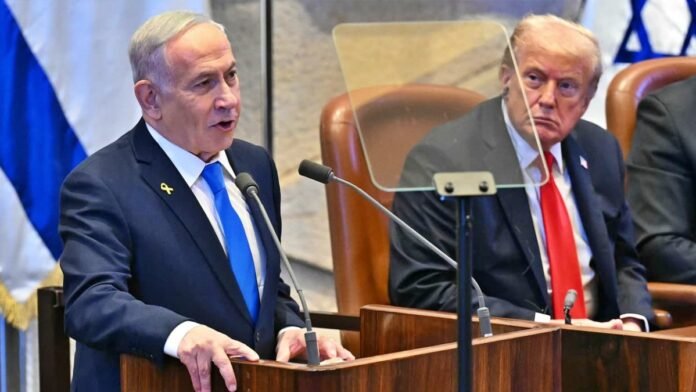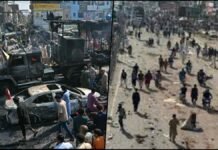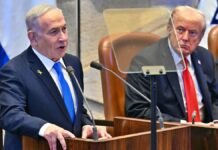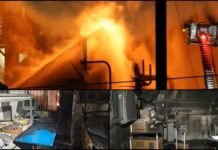
Key Points
- PM Netanyahu hailed President Trump as “the greatest friend Israel has ever had in the White House” during Knesset address on October 13, 2025
- All 20 living Israeli hostages returned home after 738 days in Hamas captivity, ending their two-year ordeal
- Trump received standing ovation from Israeli lawmakers for brokering the historic ceasefire agreement
- Israel releasing approximately 2,000 Palestinian prisoners, including 250 serving life sentences
- Thousands celebrated in Ramallah as first buses carrying freed Palestinian detainees arrived
- Trump’s four-hour Israel visit preceded Sharm el-Sheikh peace summit in Egypt with 20+ world leaders
- At least one IDF soldier reportedly killed by sniper fire despite ceasefire, raising concerns about security
- Trump hints at deploying 200 US troops to oversee truce implementation and Hamas disarmament
Tel Aviv: Israeli Prime Minister Benjamin Netanyahu delivered an impassioned address to the Knesset on Monday, October 13, 2025, praising US President Donald Trump as “the greatest friend Israel has ever had in the White House” and crediting him with unwavering support in the nation’s fight against Hamas and regional adversaries. The historic parliamentary session coincided with the emotional homecoming of all 20 living Israeli hostages who endured 738 days of captivity in Gaza, marking a watershed moment in the two-year conflict that has devastated the region.
Netanyahu’s Tribute to Trump and Peace Commitment
During his Knesset address, Netanyahu expressed profound gratitude for Trump’s role in brokering the ceasefire agreement that facilitated the hostage releases. The Israeli Prime Minister emphasized the unprecedented strength of Washington-Jerusalem ties under Trump’s leadership, highlighting the American president’s consistent support throughout Israel’s military campaign against Hamas following the devastating October 7, 2023, attack.
Netanyahu also made a significant pledge to uphold the ceasefire and pursue regional stability during his parliamentary speech. This commitment comes after months of intense domestic pressure from hostage families and their supporters, who accused the Prime Minister of prioritizing military objectives over negotiations that could have secured their loved ones’ freedom earlier. The successful release of all living hostages provides Netanyahu with considerable political capital, though questions persist about the two-year timeline required to reach this agreement.
The Prime Minister’s address to parliament came as President Trump made a lightning four-hour visit to Israel before departing for the Sharm el-Sheikh peace summit in Egypt, where he would co-chair a gathering of over 20 world leaders to advance his comprehensive Middle East peace plan. Trump’s presence in Israel during this historic moment underscored the pivotal American role in achieving the breakthrough that many had feared might never materialize.
Standing Ovation for Trump at Knesset
President Trump received a rapturous standing ovation from Israeli lawmakers during his address to the Knesset, with parliamentarians across the political spectrum acknowledging his instrumental role in securing the ceasefire and hostage release agreement. The warm reception reflected widespread Israeli gratitude for Trump’s direct intervention in negotiations that had stalled repeatedly over the preceding two years.
Speaking before the Knesset, Trump declared confidently that the Gaza war is now “over,” expressing optimism about the durability of the ceasefire despite significant challenges remaining. “The war is over. Okay? You understand that?” Trump told reporters earlier aboard Air Force One while en route to Israel. His assertive proclamation contrasted with more cautious assessments from regional experts who note that implementing subsequent phases of the peace plan will require sustained diplomatic effort and addressing deeply entrenched grievances.
Israeli President Isaac Herzog had predicted on Sunday that Trump would be welcomed by “masses of Israelis with gratitude and friendship,” and Monday’s scenes confirmed that forecast as thousands gathered to celebrate both the hostage releases and Trump’s visit. The American president’s arrival coincided with the Jewish holiday of Simchat Torah, marking exactly two years since the October 7, 2023, Hamas attack that killed over 1,200 Israelis and triggered the devastating conflict.
Emotional Scenes as All Living Hostages Return
The return of all 20 living Israeli hostages on Monday morning sparked jubilant celebrations across Israel, particularly in Tel Aviv’s Hostages Square, which has served as the emotional epicenter of advocacy efforts throughout the two-year ordeal. Tens of thousands of Israelis who had gathered at the plaza and various locations nationwide erupted in tears, cheers, and song as news spread that each hostage had safely reached Israeli custody.
The releases occurred in two phases, with Hamas first handing over seven hostages to the International Committee of the Red Cross (ICRC) in northern Gaza early Monday morning, followed by the remaining 13 captives transferred at around 7:00 AM GMT in central Gaza. The hostages, predominantly men in their 20s and 30s, included twin brothers Ziv and Gali Berman, Matan Zangauker, Bar Kuperstein, and 16 others who had been captured during the October 7, 2023, attack.
Israeli television broadcast deeply moving reunion scenes, including an emotional video call between Einav Zangauker and her 25-year-old son Matan shortly after his liberation. “There’s no war, it’s finished. You are returning home,” she told him through tears, capturing the profound relief felt by families across the nation who had endured nearly two years of anguish and uncertainty. The celebrations were tempered by remembrance of those who did not survive captivity, with Hamas obligated to return the remains of 28 deceased hostages under the ceasefire agreement.
Mixed Emotions: Joy and Grief
While jubilation dominated public reactions to the hostage releases, the celebrations were accompanied by profound grief for those who did not survive the two-year ordeal. Crowds at Hostages Square displayed a complex mixture of emotions—relief for the families being reunited with loved ones, sorrow for those receiving only remains, and lingering anger about the prolonged timeline that some believe cost lives unnecessarily.
The hostages were transported via military helicopters from the Re’im military base near Gaza to medical facilities in the Tel Aviv area, where they underwent comprehensive health assessments before reuniting with family members. The Israeli government has committed to providing extensive support throughout their rehabilitation process, though full details about their physical and psychological conditions during captivity have not been disclosed.
Many Israelis expressed frustration that the ceasefire agreement reached on October 8, 2025, contains similar frameworks to proposals discussed months or even a year earlier, raising painful questions about whether the hostages could have been released sooner. These concerns have not diminished the overwhelming national relief at seeing the captives finally return home, but they ensure that difficult conversations about the government’s handling of negotiations will continue in the weeks ahead.
Palestinian Prisoner Release Sparks Celebrations
As Israeli hostages returned home, Israel began releasing approximately 2,000 Palestinian prisoners and detainees as part of the ceasefire exchange agreement. The releases include 250 Palestinians serving life sentences in Israeli prisons, along with over 1,700 Palestinians from Gaza who were detained without charges during the conflict, including nearly two dozen children.
In Ramallah and other West Bank cities, thousands of Palestinians took to the streets to welcome the first buses carrying freed detainees, chanting “Allahu Akbar”, “God is the greatest”, in jubilant celebration. The scenes reflected the profound significance of the prisoner releases for Palestinian communities, where nearly every family has been touched by the Israeli detention system over decades of conflict.
According to Reuters, all 1,966 Palestinian prisoners scheduled for Monday’s release boarded buses at Israeli detention facilities. Of these, 1,716 individuals from Gaza were being transferred to the Nasser crossing in Gaza, while approximately 250 Palestinians serving life sentences would be released to the West Bank, Jerusalem, or abroad. The Palestinian Prisoners’ Media Office confirmed by Monday afternoon that released prisoners were en route to Gaza.
The release of prisoners serving life sentences has generated controversy within Israel, with some citizens questioning whether the price was too high for securing the hostages’ freedom. However, polls indicate that most Israelis support the exchange, viewing the return of their fellow citizens as a paramount national priority that justified the difficult concessions required.
Security Concerns: IDF Soldier Killed Despite Ceasefire
Despite the ceasefire that officially took effect on October 10, 2025, at least one Israeli Defense Forces soldier was reportedly killed by sniper fire, raising serious concerns about the agreement’s enforcement and Hamas’s compliance. The incident underscores the fragility of the peace arrangement and the considerable challenges involved in transitioning from active hostilities to sustained calm.
Israeli security officials have not provided extensive details about the circumstances of the soldier’s death, but the incident has prompted questions about whether Hamas maintains full control over armed factions within Gaza and whether all groups are committed to honoring the ceasefire terms. Some smaller militant organizations operating in Gaza have historically acted independently of Hamas directives, complicating efforts to ensure comprehensive compliance with any agreement.
The soldier’s death has also intensified debate within Israel about the wisdom of the ceasefire arrangement and whether sufficient security guarantees exist to protect Israeli forces during the phased withdrawal from Gaza envisioned under Trump’s peace plan. Netanyahu faces pressure to respond firmly to any ceasefire violations while simultaneously preserving the broader agreement that facilitated the hostage releases and could lead to lasting regional stability.
Trump Hints at US Troop Deployment
During his Israel visit, President Trump hinted at the possible deployment of approximately 200 US troops to help oversee the ceasefire implementation and facilitate Hamas’s disarmament as outlined in the second phase of his peace plan. While Trump did not provide specific details about the deployment timeline or the troops’ exact mandate, the suggestion represents a significant potential American commitment to ensuring the agreement’s success.
The proposed US military presence would likely focus on monitoring compliance, coordinating with international partners, and providing security assurances to both Israelis and Palestinians as the parties navigate the complex transition period. Trump’s peace plan envisions the creation of a new governing body for Gaza, coordinated by a US-led multinational force, as Israel gradually withdraws from the territory and Hamas relinquishes military control.
The disarmament of Hamas represents one of the most challenging components of the peace plan, as the organization has historically viewed its military capabilities as essential to resisting Israeli occupation and asserting Palestinian rights. Convincing Hamas to surrender weapons will require extensive negotiations, international guarantees about Gaza’s security and governance, and mechanisms to ensure the organization or its members can participate in civilian political processes without military power.
Sharm el-Sheikh Peace Summit
Following his four-hour Israel visit, Trump departed for Sharm el-Sheikh, Egypt, where he was scheduled to co-chair a major peace summit with Egyptian President Abdel Fattah al-Sisi and over 20 world leaders. The gathering aims to solidify the ceasefire, mobilize international support for Gaza’s reconstruction, and advance subsequent phases of Trump’s comprehensive Middle East peace plan.
Participants include British Prime Minister Keir Starmer, French President Emmanuel Macron, German Chancellor Friedrich Merz, Italian Prime Minister Giorgia Meloni, and UN Secretary-General Antonio Guterres, among other prominent international figures. The breadth of participation underscores the global significance of the peace process and the international community’s commitment to transforming this fragile ceasefire into lasting regional stability.
Trump declared before departing Israel that he has “guarantees” from key regional players about the deal’s initial phase and expressed confidence about future implementation, despite the considerable obstacles that remain. The summit is expected to produce formal commitments from participating nations to support Gaza’s reconstruction, provide humanitarian assistance, and contribute to security arrangements that can prevent future conflicts.
Humanitarian Situation and Gaza’s Future
As the ceasefire takes hold, hundreds of trucks carrying humanitarian aid have begun entering Gaza through various crossings, addressing the catastrophic crisis that has left the territory devastated by famine, disease, and displacement. Palestinians displaced to southern Gaza during Israel’s military operations have started returning to northern territories, where they are confronting widespread devastation, with large areas of Gaza City reduced to rubble.
The scale of destruction has generated urgent questions about reconstruction financing, governance structures, and Gaza’s long-term political status. International donors will need to commit billions of dollars to rebuild infrastructure, restore basic services, and provide housing for hundreds of thousands of displaced residents. These reconstruction efforts will require coordination between Israel, Palestinian authorities, Egypt, international organizations, and donor nations.
The success or failure of this ceasefire and Trump’s broader peace plan will likely define the Israeli-Palestinian conflict’s trajectory for years to come, with the international community closely watching whether this moment of hope can be transformed into the lasting peace that has eluded the region for decades. Monday’s hostage releases and prisoner exchanges represent a crucial first step, but the difficult work of building sustainable peace, ensuring security for both peoples, and addressing the conflict’s root causes has only just begun.


















































